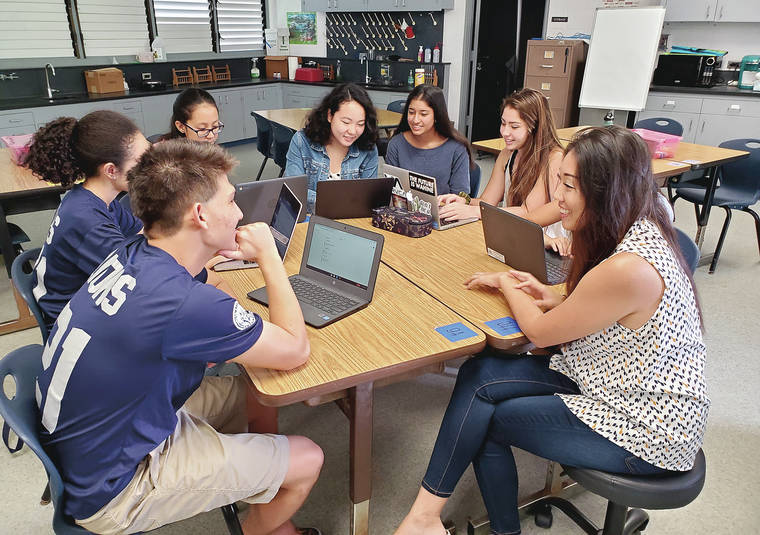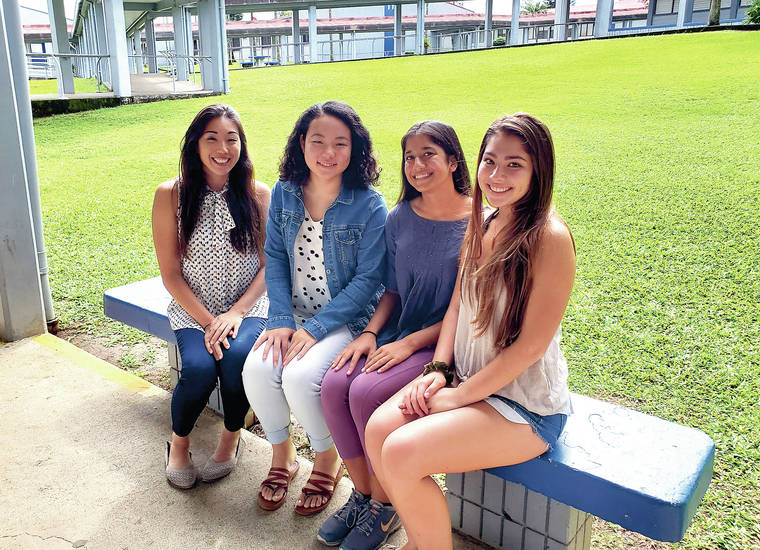Waiakea teens aim for the top at STEM competition

Whitney Aragaki’s AP research class is one of the five state finalists in the 10th annual Samsung Solve for Tomorrow Contest. (Stephanie Salmons/Tribune-Herald)

Waiakea High School teacher Whitney Aragaki, left, sits with students from her AP research class, one of the five state finalists in the 10th annual Samsung Solve for Tomorrow Contest. Pictured with Aragaki are, from left, Haruna Tomono, Gaayatri Godbole and Mari Ebersole. (STEPHANIE SALMONS/Tribune-Herald)
HILO Students at Waiakea High School are hoping their STEM studies lead to a big win in a national competition.
HILO — Students at Waiakea High School are hoping their STEM studies lead to a big win in a national competition.
Waiakea High has been named as one of the five state finalists in the 10th annual Samsung Solve for Tomorrow Contest, a nationwide competition that challenges students in grades 6-12 to use science, technology, engineering and math skills to address real-world issues in their communities.
Whitney Aragaki, who teaches the Advanced Placement research class spearheading the project, said the competition is in its 10th year.
Schools have to “find a need in your community and figure out how STEM can fill that need, so it has to be very ‘place-based,’” she explained.
This is her fifth year having students compete in the competition and the fifth year being a state finalist.
“Every year, I try to tap the intelligence and the experiences of my students to see what they see as the biggest need,” Aragaki said. “And often we try to use the novel research that is happening already in our class for different projects, as the informing perspective to what we work on.”
Winners every year have ideas that will directly affect their community, she said.
“So ideas that have naturally come out of our class have been on coral bleaching, on microplastics in the ocean, rapid ohia death, and other things,” Aragaki said. “This year, I thought with the intelligences that were in my class, they have such varied experiences, how can we bring this all together? And we’ve just been hearing a lot more ads on the radio about visitor safety and that kind of prompted our discussions about how best we could support that initiative.”
Haruna Tomono, 16, a senior in the AP research class, said the group’s proposal is to develop an app for people visiting the Big Island.
The app would include information about “touristy things,” like landmarks and historically significant objects, she said, but also would include notifications about dangerous weather conditions, ecological conditions like rapid ohia death, areas of bad cell phone reception “or other dangerous things that could get them into more trouble with first responders.”
“I noticed, while walking around and seeing other people, especially tourists, that they’re always on their phones, and they always have a cellular device,” Tomono said. “And so using that to help protect Hawaii’s environment, and the people who live in Hawaii … would be beneficial.”
Tomono said she is taking an AP computer science course and doing a research project on cybersecurity and computer science, “and so I thought that it would be interesting to use those topics that I learned in other classes to help our community …”
Senior Mari Ebersole, 17, said her efforts are focusing on the cultural perspective of the island.
“It’s such a special place because there’s so many culturally sensitive areas and it’s quite inappropriate when tourists are unaware and they enter unknowingly — but how would they have known?”
In some areas, the app will prompt visitors to take extra caution, Ebersole, whose father was a firefighter, explained, so they can “try to be conservative in their actions and be sensitive of what’s going on around them.”
Gaayatri Godbole, 16, a junior, said she has been working on the natural resources information, which would keep tourists aware of Hawaii’s various ecosystems and “delicate environment.”
“So that could be like rapid ohia death and informing them maybe they need to wash off before they exit an area or even (about) flood zones or tsunami areas,” she said. “Those are just important factors of this place that we live in that they may not be familiar with. So informing them of the risks, the dangers and also just the beauty of these areas is going to improve not only our community but maybe also their experience as they come visit our island.”
Aragaki said they’re in the process of developing the app, which doesn’t yet have a name, but movement forward is dependent on the next steps of the competition.
If the school is named the top group in the state, they get help and mentorship from Samsung scientists and engineers, she explained, “which is always a plus when you’re trying to do STEM things.”
The five state finalist classrooms will submit a lesson plan outlining how students will tackle the problem they’ve identified.
Although this is the fifth year her class has been named a finalist, Aragaki said the class has yet to advance further in the competition.
“Every year is a great idea and I think that sometimes we’re a bit overzealous in what we anticipate we can do in a year,” she said. “So we are very cognizant that what we create this year will be a prototype. It will not be a marketable thing on (app stores), but it’s a start.”
Aragaki said she hopes the students’ idea is recognized as important.
“And even if we don’t get the state award, it would be really great if we could just start promoting these conversations with larger entities in our community so that these ideas do get out and do reach the public,” she said. “But it’s also just a great experience for them to take their knowledge that they learn in school and they learned in their research, but share it with people.”
In the second round of the contest, 100 state winner schools will advance and receive $15,000 in technology and supplies.
From there, 20 national finalists will be selected in the third round to travel to the final event in the spring and will present their project to a panel of judges. They will receive $50,000 in technology and classroom materials.
Five grand prize winners will receive $100,000 in technology and classroom materials as well as a trip to Washington, D.C., to present their projects to members of Congress.
Email Stephanie Salmons at ssalmons@hawaiitribune-herald.com.


